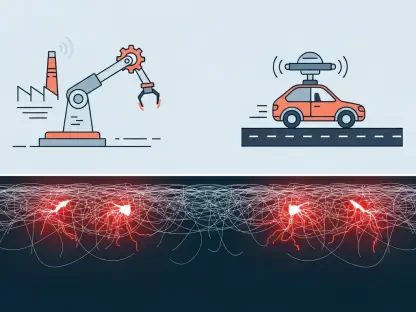In an era where network downtime can cost enterprises millions of dollars in lost productivity and revenue, the push for seamless, self-managing systems has never been more critical. Hewlett Packard Enterprise (HPE) is stepping up to this challenge with groundbreaking strides in network automation, leveraging the power of agentic AI to drive toward fully autonomous networks. Following the strategic acquisition of Juniper Networks, HPE has enhanced the Mist AI platform with cutting-edge features designed to minimize human intervention and maximize efficiency. This development marks a significant shift in the industry, where the goal is not just to react to network issues but to predict and prevent them before they occur. As businesses increasingly rely on robust digital infrastructure, HPE’s focus on self-driving networks promises to redefine operational standards, ensuring faster deployments and zero downtime. This journey toward autonomy reflects a broader trend of innovation that could transform how enterprises manage complex systems.
Pioneering Self-Driving Networks with AI
The vision of a self-driving network, where systems operate with minimal human oversight, is at the heart of HPE’s latest advancements. Through updates to the Mist AI platform, HPE is integrating agentic AI as a foundational tool to achieve level 5 automation, a state where networks can autonomously handle routine tasks and complex challenges alike. Jeff Aaron, VP of Networking Product & Solution Marketing at HPE, emphasizes that the ultimate aim is to eliminate trouble tickets and reduce the need for physical interventions, often referred to as truck rolls. By automating these processes, enterprises can redirect valuable human resources from mundane troubleshooting to strategic growth initiatives. This approach not only enhances operational efficiency but also aligns with the industry’s growing demand for systems that can anticipate user needs and adapt in real time, setting a new benchmark for network reliability and performance in a highly competitive digital landscape.
Beyond the conceptual framework, HPE’s practical innovations are already making waves in the field of network management. The Mist AI platform now features a generalized large experience model (LEM) with digital twin capabilities, enabling the integration of API and network data across wired, wireless, and WAN assets. This sophisticated system can predict potential disruptions and resolve them proactively, often before users even notice a glitch. Additionally, the Marvis AI Assistant has been made accessible directly through the data center dashboard, simplifying interaction with AI-driven tools for network administrators. These enhancements, coupled with an expanded suite of self-driving actions that autonomously tackle issues like port misconfigurations and capacity constraints, demonstrate HPE’s commitment to reducing downtime. Such advancements signify a pivotal moment in the evolution of network technology, where predictive capabilities are becoming as critical as reactive solutions.
Balancing Automation with Human Expertise
As HPE pushes the boundaries of network autonomy, a critical concern arises about the potential impact on human skills, particularly the risk of cognitive atrophy among network engineers due to over-reliance on automated systems. To address this, HPE has prioritized the implementation of explainable AI within the Mist AI platform. This approach ensures that every decision, reason, and action taken by the system is transparently documented, allowing engineers to understand and learn from AI processes rather than being sidelined by opaque algorithms. By maintaining this level of clarity, HPE aims to preserve technical expertise while still benefiting from the efficiency of automation. This balance is essential in an industry where technology evolves rapidly, and the ability to adapt and innovate remains a core competency for professionals managing increasingly complex network environments.
Another challenge in this automation journey is the existing skills gap that hinders the effective use of AI tools among some network teams. While HPE’s technology offers transformative potential, the varying levels of readiness among customers highlight the need for comprehensive training and education. Long-term users of the Mist platform often embrace self-driving features with confidence, while newer adopters tend to proceed more cautiously. Recognizing this disparity, HPE provides flexible engagement models, allowing customers to adopt automation at a pace that suits their comfort and capability levels. This tailored strategy not only fosters trust in AI-driven solutions but also underscores the importance of building a workforce equipped to handle advanced technologies. Addressing these educational needs will be crucial as the industry moves toward broader adoption of autonomous systems, ensuring that human oversight complements rather than competes with machine intelligence.
Charting the Future of Network Management
Reflecting on HPE’s recent strides, it’s evident that the integration of agentic AI into the Mist AI platform marks a turning point in the pursuit of autonomous network management. The focus on eliminating downtime and accelerating deployment times through predictive and self-driving features showcases a commitment to operational excellence. Transparent AI systems play a vital role in maintaining human expertise, while flexible adoption models accommodate diverse customer needs. These efforts position HPE as a leader in redefining how networks are managed, balancing innovation with practicality.
Looking ahead, the path to full network autonomy demands ongoing collaboration between technology providers and enterprise users to bridge the skills gap. Investing in robust training programs will empower teams to leverage AI tools effectively, ensuring that automation enhances rather than replaces human insight. As the industry evolves, continuous refinement of predictive models and user-friendly interfaces will be key to sustaining momentum. HPE’s pioneering work sets a strong foundation, but the collective focus must remain on creating adaptable, inclusive solutions that drive efficiency while preparing for the next wave of technological breakthroughs.









